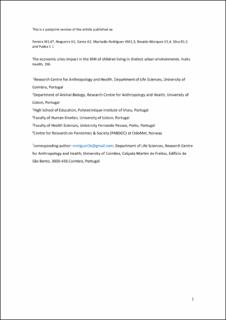| dc.contributor.author | Pereira, Margarida | |
| dc.contributor.author | Nogueira, Helena | |
| dc.contributor.author | Gama, Augusta | |
| dc.contributor.author | Machado-Rodrigues, Aristides | |
| dc.contributor.author | Rosado-Marques, Vitor | |
| dc.contributor.author | GSilva, Maria-Raquel | |
| dc.contributor.author | Padez, Cristina | |
| dc.date.accessioned | 2021-10-14T13:19:40Z | |
| dc.date.available | 2021-10-14T13:19:40Z | |
| dc.date.created | 2021-06-17T11:03:01Z | |
| dc.date.issued | 2021 | |
| dc.identifier.citation | Public Health. 2021, (196), 29-34. | en_US |
| dc.identifier.issn | 0033-3506 | |
| dc.identifier.uri | https://hdl.handle.net/11250/2823098 | |
| dc.description.abstract | Objectives
Little is known about the impact of the 2008 global economic recession on childhood obesity in Portugal. Thus, this study's goals were to compare weight status of children during and after the economic crisis according to their neighbourhood environment features and to assess changes in specific dietary habits during the economic crisis.
Study design
Cross-sectional study.
Methods
Data including weight, height, residence address to allow its geocoding and dietary habits changes during the crisis from children living in Lisbon municipality were collected in 2009 (N = 929) and in 2016 (N = 1751). A multidimensional environment index, with data of both built and socioeconomic nature collected at the statistical section level (areas comprised 300 dwellers) in the 2011 census, was used to characterize neighbourhoods.
Results
Overall, the proportion of children who are overweight or obese living in the socioeconomically vulnerable areas decreased in 2016. Families living in the latter areas stopped buying some food items, started to buy cheaper food items, cooked more meals at home and ate less in restaurants. In 2016, the risk for overweight and obesity increased in children who lived in the least advantageous areas. Living in areas with high socioeconomic status or most advantageous areas no longer represented a decreased risk of being overweight or obese in children in 2016 as it did in 2009.
Conclusions
This study suggests that the economic crisis enhanced the social inequalities regarding childhood obesity. These results aid the development of evidence-based strategies to lessen the social inequities in health outcomes created by the crisis. | en_US |
| dc.language.iso | eng | en_US |
| dc.publisher | Elsevier | en_US |
| dc.rights | Attribution-NonCommercial-NoDerivatives 4.0 Internasjonal | * |
| dc.rights.uri | http://creativecommons.org/licenses/by-nc-nd/4.0/deed.no | * |
| dc.subject | Multidimensional environment index | en_US |
| dc.subject | Childhood obesity | en_US |
| dc.subject | Global economic crisis | en_US |
| dc.title | The economic crisis impact on the body mass index of children living in distinct urban environments | en_US |
| dc.type | Peer reviewed | en_US |
| dc.type | Journal article | en_US |
| dc.description.version | acceptedVersion | en_US |
| cristin.ispublished | true | |
| cristin.fulltext | original | |
| cristin.fulltext | postprint | |
| cristin.qualitycode | 1 | |
| dc.identifier.doi | 10.1016/j.puhe.2021.04.030 | |
| dc.identifier.cristin | 1916355 | |
| dc.source.journal | Public Health | en_US |
| dc.source.issue | 196 | en_US |
| dc.source.pagenumber | 29-34 | en_US |
| dc.relation.project | SFRH/BD/133,140/2017 | en_US |
| dc.subject.nsi | VDP::Medisinske Fag: 700::Helsefag: 800::Samfunnsmedisin, sosialmedisin: 801 | en_US |
| dc.subject.nsi | VDP::Medisinske Fag: 700::Helsefag: 800::Ernæring: 811 | en_US |

